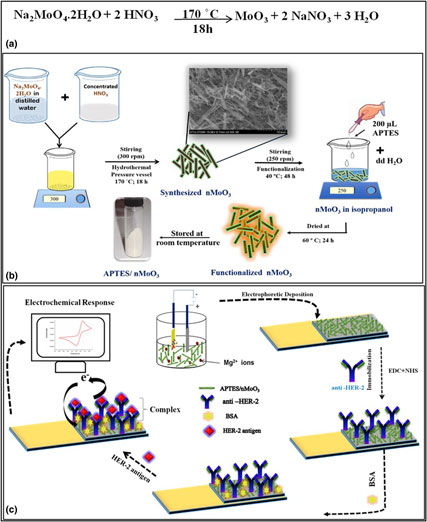Crossref Citations
This article has been cited by the following publications. This list is generated based on data provided by
Crossref.
Odularu, Ayodele T.
Ajibade, Peter A.
and
Mbese, Johannes Z.
2019.
Impact of Molybdenum Compounds as Anticancer Agents.
Bioinorganic Chemistry and Applications,
Vol. 2019,
Issue. ,
p.
1.
Augustine, Shine
Kumar, Pragati
and
Malhotra, Bansi D.
2019.
Amine-Functionalized MoO3@RGO Nanohybrid-Based Biosensor for Breast Cancer Detection.
ACS Applied Bio Materials,
Vol. 2,
Issue. 12,
p.
5366.
Sandil, Deepika
Sharma, Suresh C.
and
Puri, Nitin K.
2019.
Protein-functionalized WO3 nanorods–based impedimetric platform for sensitive and label-free detection of a cardiac biomarker.
Journal of Materials Research,
Vol. 34,
Issue. 08,
p.
1331.
Jalil, Owais
Pandey, Chandra Mouli
and
Kumar, Devendra
2020.
Electrochemical biosensor for the epithelial cancer biomarker EpCAM based on reduced graphene oxide modified with nanostructured titanium dioxide.
Microchimica Acta,
Vol. 187,
Issue. 5,
Zhumasheva, Nazerke
Kudreeva, Leyla
and
Kosybayeva, Diana
2021.
Molybdenum oxide based sensors.
Chemical Bulletin of Kazakh National University,
p.
28.
Vernet-Crua, Ada
Medina-Cruz, David
Mostafavi, Ebrahim
Benko, Aleksandra
Cholula-Diaz, Jorge Luis
Saravanan, Muthupandian
Vahidi, Hossein
Barabadi, Hamed
and
Webster, Thomas J.
2021.
Handbook on Nanobiomaterials for Therapeutics and Diagnostic Applications.
p.
511.
Ferreira, Daísy C.
Batistuti, Marina R.
Bachour, Bassam
and
Mulato, Marcelo
2021.
Aptasensor based on screen-printed electrode for breast cancer detection in undiluted human serum.
Bioelectrochemistry,
Vol. 137,
Issue. ,
p.
107586.
Tiwari, Abhishekh
Chaskar, Jyotsna
Ali, Ahmad
Arivarasan, Vishnu Kirthi
and
Chaskar, Atul Changdev
2022.
Role of Sensor Technology in Detection of the Breast Cancer.
BioNanoScience,
Vol. 12,
Issue. 2,
p.
639.
Muthumanikkam, M.
Vibisha, Alagu
Lordwin Prabhakar, Michael Cecil
Suresh, Ponnan
Rajesh, Karupiya Balasundaram
Jaroszewicz, Zbigniew
and
Jha, Rajan
2023.
Numerical Investigation on High-Performance Cu-Based Surface Plasmon Resonance Sensor for Biosensing Application.
Sensors,
Vol. 23,
Issue. 17,
p.
7495.
Zakaria, R.
Mahbub, M.
and
Lim, C.S.
2023.
Studies of surface plasmon resonance effect on different metallic layers of silver (Ag) and copper (Cu) with molybdenum trioxide (MoO3) for formaldehyde sensor.
Results in Optics,
Vol. 11,
Issue. ,
p.
100374.
Choudhari, Upasana
Gadekar, Pundlik
Ramgir, Niranjan
Jagtap, Shweta
Debnath, A. K.
and
Muthe, K. P.
2023.
Morphology-controlled synthesis of MoO3 nanostructures and its effect on heavy metal ion detection.
Journal of Materials Science: Materials in Electronics,
Vol. 34,
Issue. 25,
